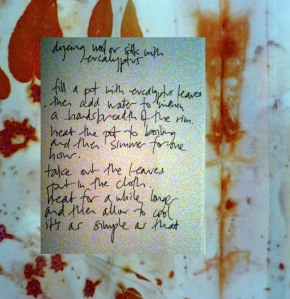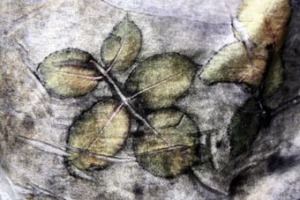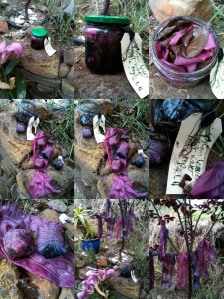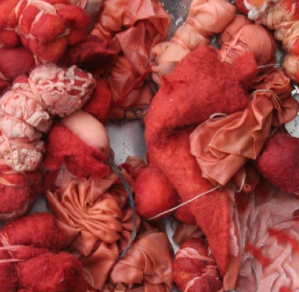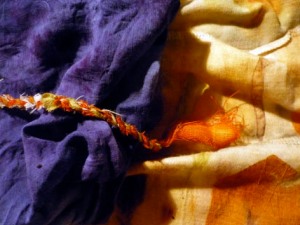You are currently browsing the category archive for the ‘resources’ category.
This post is part of the UK Herbarium blog party Gems from the Herbal Library.
When I was young, like many of that age I loved dyeing clothing. There was a magic in the transformation of an old favourite or a new opshop find simply by immersing it in coloured water. As a teen I used Dylon dyes, bought in wee metal containers from the supermarket or chemist. They were easy to use, affordable and perfect for teenage experiments. I remember the excitement when we discovered Dygon, the chemical that stripped existing colour from most cloth so it could be redyed in the colour of our choice. In my early twenties I moved on to procion dyes and screen printing, both giving me a much wider range of things to experiment and play with.
Somewhere in all that I remember collecting dandelions from the lawn of one memorable flat – the lawn was completely covered in brilliant yellow blossoms and I was sure there must be a way to get that brilliance into cloth. I don’t remember the technique I used, but the results were disappointing. The reading I did at the the time and the people I consulted all seemed to be saying that wool was relatively easy to dye, but cotton wasn’t, and either still needed chemicals of varying degrees of toxicity to make the dye take. I was already finding the procion dyes and screen printing chemicals came with impacts on human health and then when it dawned on me that those dyebaths and cleanup chemicals we were pouring down the drain at the end of the day had to actually go somewhere… well it was easiest to just stop. Occasionally I would read up some more on using plants to dye with, but it still seemed that overly toxic chemicals were needed and I could never reconcile that with the idea that people have made beautiful clothing for eons before we had those chemicals.
So it’s been my utter delight to discover the work of India Flint and other natural dye artists. Flint is an Australasian* fibre artist who has been working with plant dyes for twenty years, building up an impressive body of knowledge on what works and what we can experiment and play with successfully. What makes her work so exciting is the low level of toxicity of the substances she uses (many can be found in the kitchen), and her ecological sensibility – we can have beautiful fabric and clothing without damaging the land.
*Born and living in Australia but has connections into NZ and a deep understanding of the land here.
Flint has pioneered ‘eco-printing‘ on fabrics (using plants), and has specialised in the dye properties of many of Australia’s eucalypts (animal fibres will take eucalypt dyes without the need for any mordant).
The book Eco Colour is both a showcase of natural dyeing and an instructive on how to. A large format book, it’s is beautifully presented, with copious colour photos. These include examples of Flint’s work, the plants and the processes.
Flint has a clear communication of the problems with chemical dying – from the effect of what goes down the drain, to the impact on the dyer, and the impact on the wearer of having chemicals next to our skins (I can still sometimes pick the smell of dygon-like chemicals on commercial clothing that has obviously been through a predying process, especially wool).
I also love her ecological sensibility. On the issue of colourfastness, where commercial dyes are meant to last years and so strong, very toxic chemicals are used to achieve this, she advises that if naturally dyed cloth fades, you can simply re-dye it. For those of us that love simplicity and the magic of the dying process this is perfect.
Perhaps closest to my heart is the concept of bioregionalism. I’m a bioregional herbalist (I believe that most of our medicine can come from where we live) and Flint focusses on dying with the plants that grow around her. It’s hard to describe the importance of this sometimes, but on an obvious, practical, post-peak oil level the skill to create beauty from our landbase is invaluable.
More than that though, bioregionalism takes us into such a direct relationship with the land that it becomes impossible to not see the connections between the land, ourselves and how we treat the world. Flint’s work demonstrates and reflects that relationship, for which I am profoundly grateful. It’s not just the ability to craft fabric without excessive chemical use, it’s that the craft, the art and the play are taken back to their natural source in the land, and so are we.
In more practical terms Flint outlines many techniques: how to prepare dyes, the various mordants and what they can be used on, how time affects the process, the plants themselves and the colours they yield, health and safety (natural dyes and mordants need careful handling too), how the metal of the dyepot or resist can change colour etc. This is probably not the best book for an absolute beginner – it helps to know what a mordant is for instance, and basic dyeing techniques. Flint does explain each concept and technique as she goes, but she doesn’t give actual recipes. Natural dyes can be used by beginners more easily than harsh chemical dyes, so Eco Colour would sit well alongside a basic dyeing primer for those not used to the techniques (try the internet or library).
Many of the substances used in natural dyeing can be found at home or in the supermarket – soda, vinegar, milk – and Flint explains how these can be disposed of at the end of the dye-ing process. She also introduces the basic chemistries involved.
Although she has done extensive work with the native eucalypts, most of the plants in the book are common in many parts of the world. Further, the techniques are imminently transferable to any plant. I’m already eye-ing up plants in my neighbourhood wondering what dye would result.
There is an abundance of techniques to try out, ranging from the simple and known ordinary dye baths to the intriguing (ice dyeing) and the even more intriguing (compost dyeing). Flint intersperses the book with historical accounts, both from her own life and family traditions, her natural dyeing antecedents, and general plant dyeing background.
There are many things here to delight the herbalist. Flint talks about how plants high in alkaloids can be used as mordants and notes that many medicinal herbs will be useful in dyeing because of this. Tannin rich plants is the other obvious one.
I should point out that I’m not an artist. I have some craft skills but my experiments with plant dyes are mostly for practical purposes – how to transform the colour and look of fibre and cloth in ecologically sensitive ways, so that I can use them in my own life. While Flint is an artist and the book is for the artist’s eye, the techniques in the book are adaptable for more mundane projects too.
India Flint has a blog, and there are links there to other natural dyers the world over. Eco Colour is available from many online booksellers, and in NZ it’s also available in libraries (by interloan if your local doesn’t have it). Amazon in the UK has a Look Inside! preview that doesn’t do justice to the visual splendour of the book but does show the contents, index and introduction. Flint also travels extensively giving workshops.
I’ve been enjoying myherbcorner. From what I can tell Brigitte is German Austrian, living in NZ. It’s lovely seeing the European tradition of herbalism being talked about (as it’s different than the NZ, UK, and US herbalism which is where most of our NZ knowledge of non-native medicines comes from). She has a wiki too, worth checking out.
Not herbal as such, but a Te Wai Pounamu/Mainland blog! (that’s the South Island for international readers). Letter from Wetville is Sandra’s writing on life on the West Coast. Gardening, daily life and political commentary on related topics, she’s also been doing some thoughtful posts lately on NZ women’s history.
I’ve dropped a few blog links to the left there. I thought as I add others I’d write a bit about them and what they’re good for. So starting with the NZ ones:
Farmlet: a couple (one Kiwi, one Californian, and their baby) on a small farm in the Far North doing the back to the land, self sufficiency thing. Lots of practical posts about all aspects of their lives – farming, food, household management, the development of the farm and their lives there. They’ve been blogging for 3 years so heaps of posts in the backlog to delve into.
Johanna Knox: writer, mother, ethicurean, Wellingtonian, Johanna blogs about wild foods, solar cooking, publishing in the power down age, and general post-peak oil/climate change stuff. You can hear her on National Radio’s This Way Up some Saturdays (or see the RNZ website for the podcasts) showing Simon around the edible weeds in Welly. Johanna has several blogs on various things, including some good photos of weeds. She’s much better on wild plant recipes than I will ever be, so check out her blog of tasty treats and adaptations of conventional recipes.
Pohangina Pete: natural history blogger, fantastic photographs and explorations of NZ (wild)life. He gets quite a few comments from overseas, and has footnotes to his articles. Footnotes and links! Pohangina is in the North Island somewhere, not sure where exactly ‘cos you know that’s another country up there ;-)
Hmm, and they’re all North Island ones…

